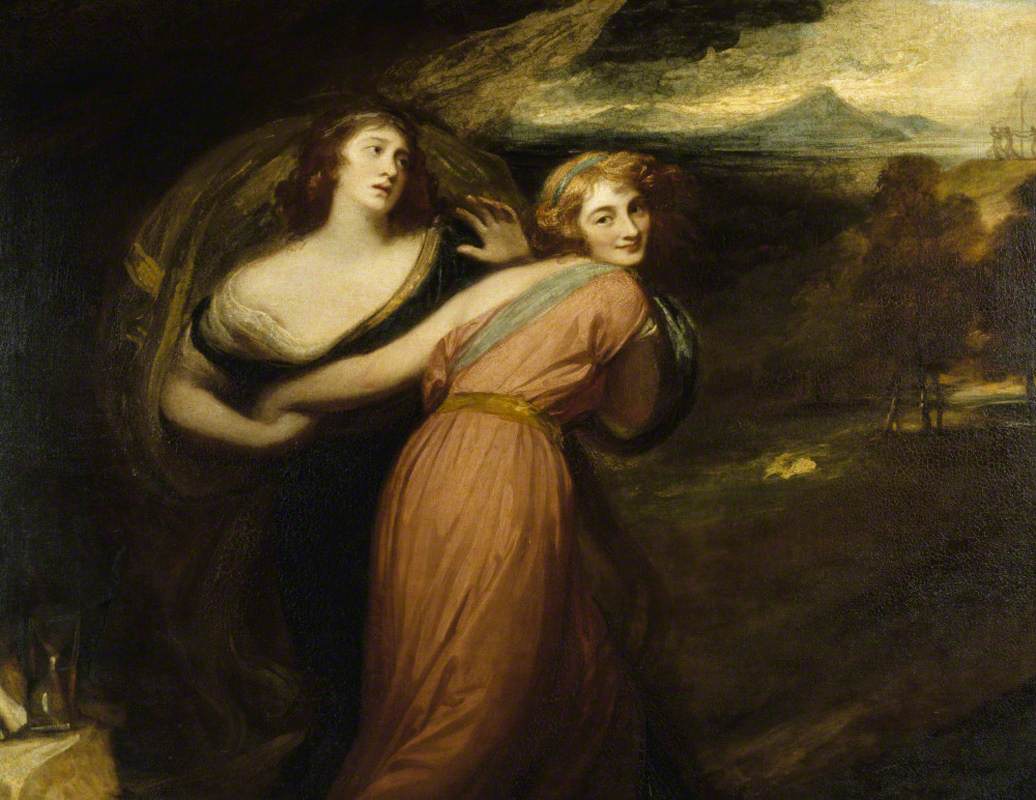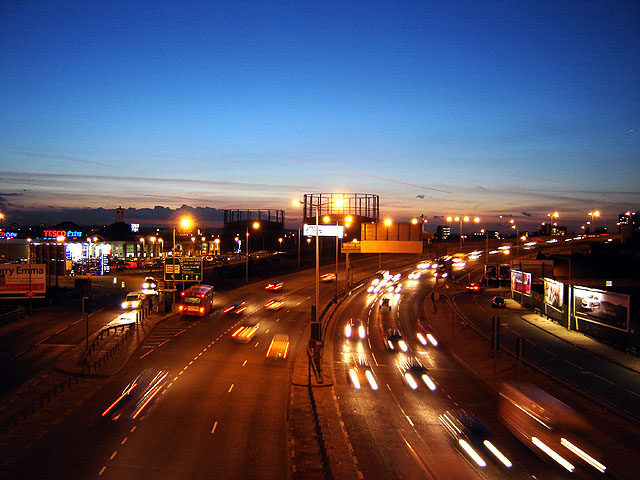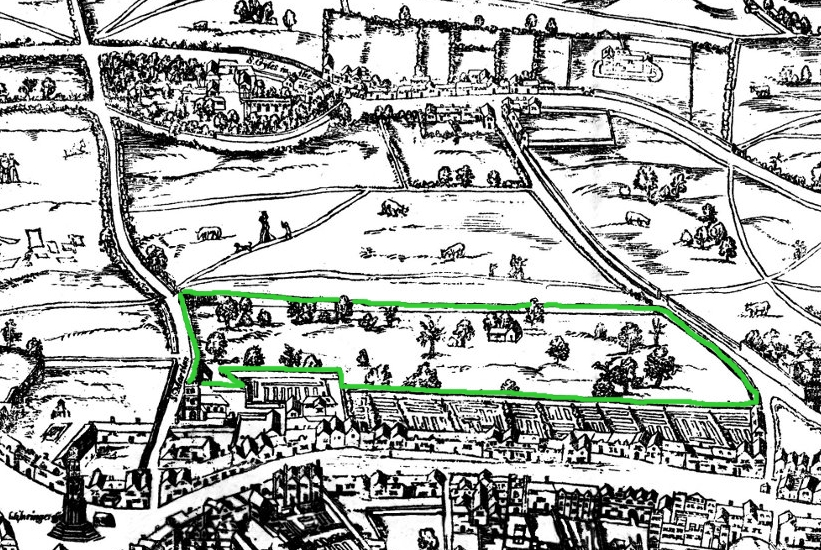|
Tryphosa Jane Wallis
Tryphosa Jane Wallis or Tryphosa Jane Campbell or Miss Wallis from Bath (11 January 1774 – 29 December 1848) was a British actress. Life Wallis was born on 11 January 1774 to a theatrical family in Richmond although her paternal grandfather was a church minister in Ireland. Her talent was adopted and championed by Lord and Lady Loughborough from 1785 and she went on to appear at Covent Garden in 1789. Wallis was a popular performer who sometimes experienced mixed reviews. Some thought that her success was largely due to her adoption by the Lord Chancellor of England. She was particularly successful as an actress in Bath for several years. She was brought back to London to appear at Covent Garden by Thomas Harris who was trying to compete with competition from Drury Lane. She apologised to her followers in Bath for leaving, noting that her only motive was the inflated salary which she needed not for herself but her many siblings. This speech added to her noble reputation. At C ... [...More Info...] [...Related Items...] OR: [Wikipedia] [Google] [Baidu] |
John Graham (painter)
John Graham (17541 November 1817) was an 18th-century Scottish painter and teacher of art. Life Graham was born in Edinburgh and apprenticed to a coach-painter in Edinburgh, George MacFarquhar. He next moved to London and became a coach-painter. He started studying at the Royal Academy Schools and exhibited there between 1780 and 1797. Graham also painted an ''Othello and Desdemona'' for John Boydell's Shakespeare Gallery.Thomson, “John Graham”. Graham was nominated four times between 1793 and 1797 for associate membership to the Royal Academy, but failed to win election. Duncan Thomson, in his article in the ''Oxford Dictionary of National Biography'', paraphrases Joseph Farington, who told Thomas Lawrence, that "Graham was a candidate he would certainly not vote for, in what he considered a very weak field". Thomson speculates that these failures prompted Graham to consider returning to Scotland. Through the influence of the banker Sir William Forbes, Graham acquired ... [...More Info...] [...Related Items...] OR: [Wikipedia] [Google] [Baidu] |
Edmonton, Middlesex
Edmonton is a town in north London, England within the London Borough of Enfield, a local government district of Greater London. The northern part of the town is known as Lower Edmonton or Edmonton Green, and the southern part as Upper Edmonton. Situated north-northeast of Charing Cross, it borders Enfield to the north, Chingford to the east, and Tottenham to the south, with Palmers Green and Winchmore Hill to the west. The population of Edmonton was 82,472 as of 2011. The town forms part of the ceremonial county of Greater London and until 1965 was in the ancient county of Middlesex. Historically a parish in the Edmonton Hundred of Middlesex, Edmonton became an urban district in 1894, and a municipal borough in 1937. Local government took place at the now-demolished Edmonton Town Hall in Fore Street between 1855 and 1965. In 1965, following reform of local government in London, the municipal borough and former parish of Edmonton was abolished, merging with that of Enfiel ... [...More Info...] [...Related Items...] OR: [Wikipedia] [Google] [Baidu] |
United Kingdom
The United Kingdom of Great Britain and Northern Ireland, commonly known as the United Kingdom (UK) or Britain, is a country in Europe, off the north-western coast of the continental mainland. It comprises England, Scotland, Wales and Northern Ireland. The United Kingdom includes the island of Great Britain, the north-eastern part of the island of Ireland, and many smaller islands within the British Isles. Northern Ireland shares a land border with the Republic of Ireland; otherwise, the United Kingdom is surrounded by the Atlantic Ocean, the North Sea, the English Channel, the Celtic Sea and the Irish Sea. The total area of the United Kingdom is , with an estimated 2020 population of more than 67 million people. The United Kingdom has evolved from a series of annexations, unions and separations of constituent countries over several hundred years. The Treaty of Union between the Kingdom of England (which included Wales, annexed in 1542) and the Kingdom of Scotland in 170 ... [...More Info...] [...Related Items...] OR: [Wikipedia] [Google] [Baidu] |
Mirth And Melancholy Painting By Romney
Mirth may refer to: * Gladness and gaiety, especially when expressed by laughter * Mirth Connect, software for conversion between health record standards * Mirth Provisions Mirth Provisions is a company that sells cannabis-infused beverages. Mirth was founded in 2014 by Adam Stites and is based in Longview, Washington. Mirth's beverage brand is Legal, which is available in several flavors, the first of which was col ..., a cannabis company based in Longview, Washington * USS ''Mirth'' (AM-265), a World War II ''Admirable''-class minesweeper used by the U.S. Navy 1943-1945 {{disambiguation ... [...More Info...] [...Related Items...] OR: [Wikipedia] [Google] [Baidu] |
Richmond, Yorkshire
Richmond is a market town and civil parish in North Yorkshire, England, and the administrative centre of the district of Richmondshire. Historically in the North Riding of Yorkshire, it is from the county town of Northallerton and situated on the eastern edge of the Yorkshire Dales National Park, and is one of the park's tourist centres. The population of Richmond at the 2011 census was 8,413. The Rough Guide describes the town as 'an absolute gem'. Betty James wrote that "without any doubt Richmond is the most romantic place in the whole of the North East f England. Richmond was the winner of the Academy of Urbanism's "Great Town" award in 2009. History The town of Richemont, in Normandy (now in the Seine-Maritime département of the Upper Normandy region), was the origin of the place name Richmond. It is the most duplicated UK place name, with 56 occurrences worldwide. Richmond in North Yorkshire was the Honour of Richmond of the Earls of Richmond (or ''comtes de Richemon ... [...More Info...] [...Related Items...] OR: [Wikipedia] [Google] [Baidu] |
Alexander Wedderburn, 1st Earl Of Rosslyn
Alexander Wedderburn, 1st Earl of Rosslyn, PC, KC (3 February 1733 – 2 January 1805) was a Scottish lawyer and politician who sat in the House of Commons between 1761 and 1780 when he was raised to the peerage as Baron Loughborough. He served as Lord High Chancellor of Great Britain from 1793 to 1801. Life Wedderburn was the eldest son of Peter Wedderburn, Lord Chesterhall (a lord of session), and was born in East Lothian. He received his basic education at Dalkeith and at the Royal High School, Edinburgh, and matriculated at the University of Edinburgh aged 14. Though he wanted to practise at the English bar, in deference to his father's wishes he qualified as an advocate at Edinburgh, in 1754. His father was called to the bench in 1755, and for the next three years Wedderburn stuck to his practice in Edinburgh, when he employed his oratorical powers in the General Assembly of the Church of Scotland, and passed his evenings in social and argumentative clubs. In 1755 t ... [...More Info...] [...Related Items...] OR: [Wikipedia] [Google] [Baidu] |
Covent Garden
Covent Garden is a district in London, on the eastern fringes of the West End, between St Martin's Lane and Drury Lane. It is associated with the former fruit-and-vegetable market in the central square, now a popular shopping and tourist site, and with the Royal Opera House, itself known as "Covent Garden". The district is divided by the main thoroughfare of Long Acre, north of which is given over to independent shops centred on Neal's Yard and Seven Dials, while the south contains the central square with its street performers and most of the historical buildings, theatres and entertainment facilities, including the London Transport Museum and the Theatre Royal, Drury Lane. The area was fields until briefly settled in the 7th century when it became the heart of the Anglo-Saxon trading town of Lundenwic, then abandoned at the end of the 9th century after which it returned to fields. By 1200 part of it had been walled off by the Abbot of Westminster Abbey for use as arable l ... [...More Info...] [...Related Items...] OR: [Wikipedia] [Google] [Baidu] |
Bath, Somerset
Bath () is a city in the Bath and North East Somerset unitary area in the county of Somerset, England, known for and named after its Roman-built baths. At the 2021 Census, the population was 101,557. Bath is in the valley of the River Avon, west of London and southeast of Bristol. The city became a World Heritage Site in 1987, and was later added to the transnational World Heritage Site known as the "Great Spa Towns of Europe" in 2021. Bath is also the largest city and settlement in Somerset. The city became a spa with the Latin name ' ("the waters of Sulis") 60 AD when the Romans built baths and a temple in the valley of the River Avon, although hot springs were known even before then. Bath Abbey was founded in the 7th century and became a religious centre; the building was rebuilt in the 12th and 16th centuries. In the 17th century, claims were made for the curative properties of water from the springs, and Bath became popular as a spa town in the Georgian era. ... [...More Info...] [...Related Items...] OR: [Wikipedia] [Google] [Baidu] |
Thomas Harris (theatre Manager)
Thomas Harris (died 1820) was an English theatre manager, who became proprietor of Covent Garden Theatre. Life His background was in business. In the autumn of 1767, with George Colman the elder, John Rutherford, and William Powell, he purchased from John Beard the patent of Covent Garden Theatre. The theatre opened 14 September 1767, with '' The Rehearsal'', in which Powell spoke a prologue by William Whitehead. Colman took on a management role, but a serious quarrel broke outbetween Harris and Colman arose during the first season, driven by the ambitions of Jane Lessingham, an actress with whom Harris lived. Colman, with whom Powell sided, barricaded the theatre, and Harris, supported by Rutherford, broke it forcibly open. Legal proceedings and a pamphlet war followed. On 23 July 1770 a legal decision of the commissioners of the Great Seal reinstated Colman as acting manager, subject to the advice and inspection, but not the control, of his fellows. Powell meanwhile had died 3 ... [...More Info...] [...Related Items...] OR: [Wikipedia] [Google] [Baidu] |
Theatre Royal, Drury Lane
The Theatre Royal, Drury Lane, commonly known as Drury Lane, is a West End theatre and Grade I listed building in Covent Garden, London, England. The building faces Catherine Street (earlier named Bridges or Brydges Street) and backs onto Drury Lane. The building is the most recent in a line of four theatres which were built at the same location, the earliest of which dated back to 1663, making it the oldest theatre site in London still in use. According to the author Peter Thomson, for its first two centuries, Drury Lane could "reasonably have claimed to be London's leading theatre". For most of that time, it was one of a handful of patent theatres, granted monopoly rights to the production of "legitimate" drama in London (meaning spoken plays, rather than opera, dance, concerts, or plays with music). The first theatre on the site was built at the behest of Thomas Killigrew in the early 1660s, when theatres were allowed to reopen during the English Restoration. Initially ... [...More Info...] [...Related Items...] OR: [Wikipedia] [Google] [Baidu] |
George Romney (painter)
George Romney ( – 15 November 1802) was an English portrait painter. He was the most fashionable artist of his day, painting many leading society figures – including his artistic muse, Emma Hamilton, mistress of Lord Nelson. Early life and training Romney was born in Beckside in Dalton-in-Furness, Lancashire (now in Cumbria), the 3rd son (of 11 children) of John Romney, cabinet maker, and Anne Simpson. Raised in a cottage named High Cocken in modern-day Barrow-in-Furness, he was sent to school at nearby Dendron. He appears to have been an indifferent student and was withdrawn at the age of 11 and apprenticed to his father's business instead. He proved to have a natural ability for drawing and making things from wood – including violins (which he played throughout his life). From the age of 15, he was taught art informally by a local watchmaker called John Williamson, but his studies began in earnest in 1755, when he went to Kendal, at the age of 21, for a 4-year appr ... [...More Info...] [...Related Items...] OR: [Wikipedia] [Google] [Baidu] |
1774 Births
Events January–March * January 21 – Mustafa III, Sultan of the Ottoman Empire, dies and is succeeded by his brother Abdul Hamid I. * January 27 ** An angry crowd in Boston, Massachusetts seizes, tars, and feathers British customs collector and Loyalist John Malcolm, for striking a boy and a shoemaker, George Hewes, with his cane. ** British industrialist John Wilkinson patents a method for boring cannon from the solid, subsequently utilised for accurate boring of steam engine cylinders. * February 3 – The Privy Council of Great Britain, as advisors to King George III, votes for the King's abolition of free land grants of North American lands. Henceforward, land is to be sold at auction to the highest bidder. * February 6 – France's Parliament votes a sentence of civil degradation, depriving Pierre Beaumarchais of all rights and duties of citizenship. * February 7 – The volunteer fire company of Trenton, New Jersey, predecessor to the paid Trenton Fire ... [...More Info...] [...Related Items...] OR: [Wikipedia] [Google] [Baidu] |









.jpg)